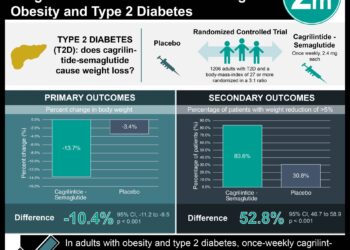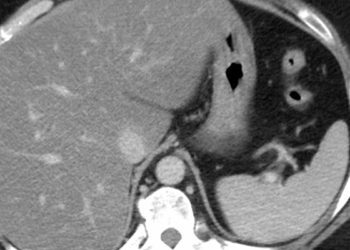2 Minute Medicine Rewind October 26 – November 1, 2015
The routine use of long-acting β-agonists (LABA) for symptomatic control among patients with asthma is often questioned for its safety. Studies have attributed allelic variation at the Arg16Gly locus of the β2-adrenergic receptor for the increased rates of adverse events, especially among black patients. The BELT study was a parallel-group randomized controlled trial that enrolled 1070 black patients between 18-75 years and scored ACQ>1.25, with moderate to severe asthma in 20 practice sites to be randomized in a 1:1 fashion to receive LABA + inhaled steroids (ICS) vs tiotropium + ICS. The primary outcome was time to asthma exacerbation defined as needing oral or parenteral steroids. Analysis indicated no differences in time to first exacerbation in the LABA group (rate ratio 0.90; 95% CI 0.73 to 1.11; log-rank p = 0.31. Furthermore, there was no difference in change in FEV1 at 12 months (between-group differences 0.020; 95% CI −0.021 to 0.061; p = 0.33) or at 18 months (between-group differences 0.025; 95% CI −0.045 to 0.095; p =0.49). Lastly, Arg16Gly ADRB2 alleles were not associated with differences between the two groups. The main limitations for this study were the lack of a placebo-control, the inclusion of a single racial group and the physician’s subjectivity in assessing asthma status. In all, this study showed that twice-daily LABA with ICS was not superior to once-daily tiotropium with ICS in reducing asthma exacerbations or preserving lung functions. Furthermore, Arg16Gly polymorphism of ADRB2 did not result in a differential response to therapy.
Paclitaxel-Eluting versus Everolimus-Eluting Coronary Stents in Diabetes
While everolimus-eluting stents have been shown to be superior to paclitaxel-eluting stents per clinical endpoints in the majority of patients, results in the diabetic subgroup have been variable. The TUXEDO trial was a multicenter randomized clinical trial involving 1830 patients with diabetes mellitus (DM) and coronary artery disease (CAD) undergoing percutaneous intervention (PCI) to receive either paclitaxel vs everolimus eluting stents. Eligibility criteria required presence of DM, symptomatic CAD, and lesions 34mm or less in length and a reference vessel diameter between 2.25mm and 4.0mm. The primary end point was target-vessel failure at 1 year defined as a composite of cardiac death, target-vessel myocardial infarction, or ischemia-driven target-vessel revascularization. The trial was powered to detect noninferiority with respect to the primary end point of target-vessel failure at 1 year. In the intention-to-treat analysis, paclitaxel-eluting stents failed to meet the criteria for noninferiority (5.6% vs. 2.9%; RR 1.89; 95% CI 1.20 to 2.99; p=0.38). Furthermore, at 1 year, patients receiving paclitaxel-eluting stents had significantly higher rates of target-vessel revascularization and target-lesion revascularization (3.4% vs. 1.2% for both end points; P=0.002). They also had higher rates of spontaneous myocardial infarction, (3.2% vs. 1.2%; P=0.004) and stent thrombosis (2.1% vs. 0.4%; P=0.002). Limitations of the study included lower than anticipated event rates and inclusion of only Asian Indians limiting the study’s generalizability. The TUXEDO trial showed that paclitaxel-eluting stents failed the non-inferiority trial as compared with everolimus eluting stents in the diabetic population. Furthermore, everolimus stents were superior in regards to the endpoints of target-vessel failure, myocardial infarction, and stent thrombosis.
Previous phase 1 and 2 studies have showed promise of nedaplatin and docetaxel in advanced squamous cell lung carcinoma. This study was a randomized, open label, phase 3 study across 53 centers in Japan involving 355 patients who were assigned to receive nedaplatin + docetaxel vs cisplatin + docetaxel. Eligibility criteria included pathologically proven squamous cell lung cancer with stage IIIB/IV or postoperative recurrence, ECOG of 0-1 and no previous chemotherapy or recurrence more than a year after previous adjuvant chemotherapy. Patients were randomly assigned to 100 mg/m2 nedaplatin and 60 mg/m2 docetaxel intravenously, or 80 mg/m2 cisplatin and 60 mg/m2 docetaxel, every 3 weeks for four to six cycles. The primary endpoint was overall survival from date of randomization until death from any cause. Analysis showed that overall survival (OS) was significantly longer in the nedaplatin group (median OS 13.6 months; 95% CI 11.6 to 15.6) versus that in the cisplatin group (median OS 11.4 months; 95% CI 10.2 to 12.2). Hazard ratios was 0.81 (95% CI 0.65 to 1.02; p=0.037). Furthermore, nedaplatin offered improved tolerability compared to cisplatin with respect to nausea (7 of 177 patients vs 25 of 175), fatigue (6 vs 20), hyponatremia (24 vs 53), and hypokalemia (4 vs 15). However, leukopenia (98 vs 77), neutropenia (146 vs 123), and thrombocytopenia (16 vs 0) were more frequent in the nedaplatin group than in the cisplatin group. The main limitations of this study were the inclusion of only Japanese patients, who are pharmacogenomically different from Western populations. In conclusion, this study demonstrated that overall survival was longer with nedaplatin + docetaxel vs cisplatin + docetaxel with differing safety profiles of the two regimens.
The administration of intravenous saline for increasing intravascular volume is frequently used in the ICU. However, emerging studies suggest that the excess chloride content of normal saline (NS) contributes to the development of acute kidney injury (AKI). The SPLIT trial was a prospective, blinded, cluster-randomized study over 4 ICUs in New Zealand that compared NS versus PL-148, a buffered crystalloid solution, in 2278 ICU patients not receiving dialysis. The primary outcome was proportion of patients with AKI, defined as a rise in serum creatinine of at least twofold or a serum creatinine level of ≥3.96 mg/dL with an increase of ≥0.5 mg/dL. In the buffered crystalloid group, 102 of 1067 patients (9.6%) developed AKI within 90 days after enrollment compared with 94 of 1025 patients (9.2%) in the saline group. Absolute difference was 0.4% (95% CI −2.1% to 2.9%; RR 1.04; 95% CI 0.80 to 1.36; p = 0.77). The need for RRT was not statistically significant between the two groups, 38 of 1152 patients (3.3%) in the crystalloid group compared with 38 of 1110 patients (3.4%) in the saline group with absolute difference of −0.1% (95% CI −1.6% to 1.4%; RR 0.96; 95% CI 0.62 to 1.50; p = 0.91). Additionally, 87 of 1152 patients (7.6%) in the buffered crystalloid group versus 95 of 1110 patients (8.6%) in the saline group died in the hospital with absolute difference of −1.0% (95% CI −3.3% to 1.2%; RR 0.88; 95% CI 0.67 to 1.17; p = 0.40. The most important limitations of this study were the lack of initial sample size calculations as well as the fact that over 90% of patients were already exposed to intravenous fluids, mostly to a buffered crystalloid, before enrollment. Lastly, this study had a heterogeneous population with a low incidence of AKI to begin with. Overall, this exploratory study did not show the benefits of buffered crystalloid fluid therapy in the ICU, however, larger randomized trials need to assess the efficacy of buffered crystalloids in high risk populations.
Stroke risk stratification in acute dizziness presentations
Patients with dizziness secondary to stroke are difficult to identify because they often lack typical stroke warning symptoms. This study was a prospective, single center observational study that enrolled 320 patients and aimed to risk stratify stroke in patient with dizziness. Inclusion criteria were continuing dizziness, nystagmus or objective and subjective imbalance with ambulation. The independent variables that were assessed included the ABCD2 score, blood pressures > 140/90, unilateral weakness, nystagmus, ocular motor (OM) category and other neurological symptoms. A multivariable logistic regression model was constructed with dependent variable of acute infarction or intracerebral hemorrhage on MRI. The analysis showed stroke in 29 of 272 patients (10.7%). Stroke was associated with ABCD2 score (OR 1.74; 95% CI 1.20 to 2.51), other CNS features (OR 2.54; 95% CI 1.06 to 6.08), OM assessment (OR 2.82; 95% CI 0.96 to 8.30) and prior stroke (OR 0.48; 95% CI 0.05 to 4.57). This study was limited to a single center, which limits the study’s generalizability. Furthermore, this study’s focus on only of acute infarction/ICH likely increased the importance of ABCD2 relative to other markers in the analysis. In conclusion, this study successfully identified certain bedside characteristics in patients with dizziness that are suggestive of stroke.
Image: PD
©2015 2 Minute Medicine, Inc. All rights reserved. No works may be reproduced without expressed written consent from 2 Minute Medicine, Inc. Inquire about licensing here. No article should be construed as medical advice and is not intended as such by the authors or by 2 Minute Medicine, Inc.







![Adverse pregnancy outcomes associated with thrombophilias [Classics Series]](https://www.2minutemedicine.com/wp-content/uploads/2015/07/Classics-2-Minute-Medicine-e1436017941513-75x75.png)